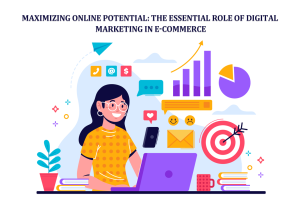Imagine that you’ve made a lot of effort on your e-commerce business. You have a fantastic selection of products, a user-friendly website, and a mobile app. Despite this, your online store is still without customers. They simply aren’t finding you in the vast sea amidst all your competition.
This is, unfortunately, a common scenario for many e-commerce businesses. The online marketplace has a lot of competition, all working desperately for the attention of the same group of potential customers. This is where digital marketing steps in to help you. Without digital marketing, your online spaces, like your website and social media, will remain unseen by your target audience.
This article delves into decoding digital marketing. We’ll focus on understanding the e-commerce landscape, defining and understanding digital marketing, and digital marketing channels for e-commerce. Now, let’s begin!
The E-Commerce Landscape
E-commerce, short for electronic commerce, refers to the buying and selling of goods and services over the Internet. It encompasses various transactions, from consumers purchasing clothing from online retailers (B2C) to businesses procuring office supplies from wholesalers online (B2B).
E-Commerce Models
The e-commerce landscape has some models that differ depending on the buyer and the seller.
- Business-to-Consumer (B2C): Businesses sell directly to individual consumers. A popular example is Amazon.
- Business-to-Business (B2B): Businesses sell products or services to other businesses. Examples include online platforms where restaurants order wholesale ingredients or construction companies purchase building materials.
- Consumer-to-Consumer (C2C): Consumers sell products or services to other consumers. Online marketplaces like Craigslist fall into this category.
- Consumer-to-Business (C2B): Consumers sell goods or services directly to businesses. An example is freelance marketplaces where businesses hire writers or graphic designers.
E-Commerce on the Rise
The growth of e-commerce has been nothing short of phenomenal. The convenience, competitive pricing, and vast selection of online stores have significantly impacted traditional brick-and-mortar retail. Many consumers now prefer the ease of shopping from home, leading to the closure of physical stores and the rise of omnichannel retailers integrating online and offline experiences.
Challenges in the Digital Marketplace
Even with all the success, online businesses face some challenges:
- High competition
- Customer acquisition costs
- Online brand awareness
Moreover, choosing the right e-commerce platform for your business needs is essential. Popular options include Shopify, BigCommerce, and WooCommerce. You can use the WooCommerce Private Store plugin to cater to businesses requiring a membership-based or password-protected storefront.
Decoding Digital Marketing
In simpler terms, digital marketing refers to all your online efforts to promote your e-commerce business and its offerings. It’s about leveraging the power of the Internet to connect with potential customers, generate interest in your products, and ultimately convert them into paying customers.
The Core Objective of Digital Marketing
For e-commerce businesses, the core objective of digital marketing boils down to two things: reaching your target audience and driving sales.
Reaching your target audience involves strategies like targeted advertising and content marketing that resonates with your ideal customer profile. Once you’ve captured their attention, digital marketing helps convert website visitors into paying customers. This can be achieved through persuasive product descriptions, strategic promotions, and a user-friendly online shopping experience.
The Digital Marketing Mix
The concept of the marketing mix, traditionally used for product, price, place, and promotion, can be adapted to the digital realm for e-commerce businesses:
- Product: In the digital world, showcasing your products goes beyond just displaying pictures. Digital marketing allows you to create high-quality product images and videos, highlight key features and benefits through compelling product descriptions, and leverage customer reviews and testimonials to build trust.
- Price: Digital marketing isn’t just about promoting your products; it’s also about effectively communicating your pricing strategy. You can utilize targeted ads to highlight competitive pricing or showcase limited-time promotions to incentivize immediate purchases.
- Place: In the e-commerce world, your “place” is your digital storefront. This encompasses your website, where user experience is paramount, and your presence on online marketplaces like Amazon or eBay. Your social media platforms can also act as an extension of your online store, allowing for product discovery and engagement with potential customers.
- Promotion: This is where the magic of various digital marketing channels comes into play. It includes SEO, SEM, content marketing, social media marketing, and email marketing.
Key Digital Marketing Channels for E-Commerce
Now that we’ve established the importance of digital marketing for e-commerce businesses let’s delve into the key channels that form your digital marketing toolbox:
Search Engine Optimization (SEO)
Effective SEO ensures your e-commerce website appears at the top of search engine results pages (SERPs), allowing consumers to find your products quickly. Here are the main points:
- Increased Visibility: SEO optimizes your website content and technical aspects to rank higher for relevant keywords. This organic visibility translates to more website traffic and potential customers.
- On-Page vs. Off-Page SEO: SEO involves on-page optimization (optimizing website content, title tags, and meta descriptions) and off-page optimization (building backlinks from other websites).
- Keyword Magic: Identifying and incorporating relevant keywords is crucial for e-commerce SEO. Consider the search terms your target audience might use to find products like yours and optimize your content accordingly.
Search Engine Marketing (SEM)
While SEO focuses on organic search results, SEM allows you to pay for targeted advertising on search engines.
- Paid Advertising (PPC): SEM utilizes the Pay-Per-Click (PPC) model, where you only pay when someone clicks on your ad. Popular platforms like Google Ads allow you to create targeted ads displayed on search engine result pages and other partner websites.
- Reaching the Right Audience: The beauty of PPC lies in its targeting capabilities. You can define specific demographics, interests, and online behaviors to ensure your ads reach the most relevant potential customers.
Content Marketing
Valuable content is a powerful magnet for attracting and engaging potential customers.
- Content that Converts: Instead of pushing products, create informative and engaging content that educates your audience, addresses their pain points, and showcases your brand expertise. This could be blog posts on industry trends, product tutorials, or visually appealing infographics.
- Building Trust and Authority: By consistently providing valuable content, you establish yourself as a thought leader in your niche and build trust with potential customers. This makes them more likely to consider your brand when making a purchase.
Social Media Marketing
Social media platforms offer a dynamic space for brand awareness, community building, and customer engagement.
- The Power of Social: Utilize platforms like Instagram, Facebook, or TikTok (depending on your target audience) to showcase your products in a visually appealing way, run interactive contests, and foster conversations with potential customers.
- Finding the Right Platform: Different social media platforms cater to different demographics and preferences. Identify which platforms your target audience frequents the most and tailor your content strategy accordingly.
Email Marketing
Don’t underestimate the power of email! It remains a highly effective channel for promotions, personalized offers, and customer retention.
- Targeted Communication: Build an email list by offering valuable incentives and segmenting your audience based on their interests and purchase history. This allows you to send targeted email campaigns with personalized offers and promotions that resonate more effectively.
- Crafting Compelling Emails: Design visually appealing emails with clear calls to action. Leverage automation tools to send personalized welcome emails, abandoned cart reminders, and exclusive offers to nurture leads and drive sales.
Conclusion
The dynamic nature of the e-commerce landscape means that new technologies and marketing trends emerge constantly. Thus, your e-commerce business must embrace a data-driven approach and continuously refine your digital marketing strategies.
By effectively utilizing the key channels discussed in this article, you can establish a solid online presence, attract your target audience, and convert website visitors into loyal customers. Remember, a successful digital marketing strategy is not a one-time effort; it’s an ongoing journey of optimization and adaptation.
Embrace the power of digital marketing, and watch your e-commerce business thrive in the ever-expanding online marketplace.







